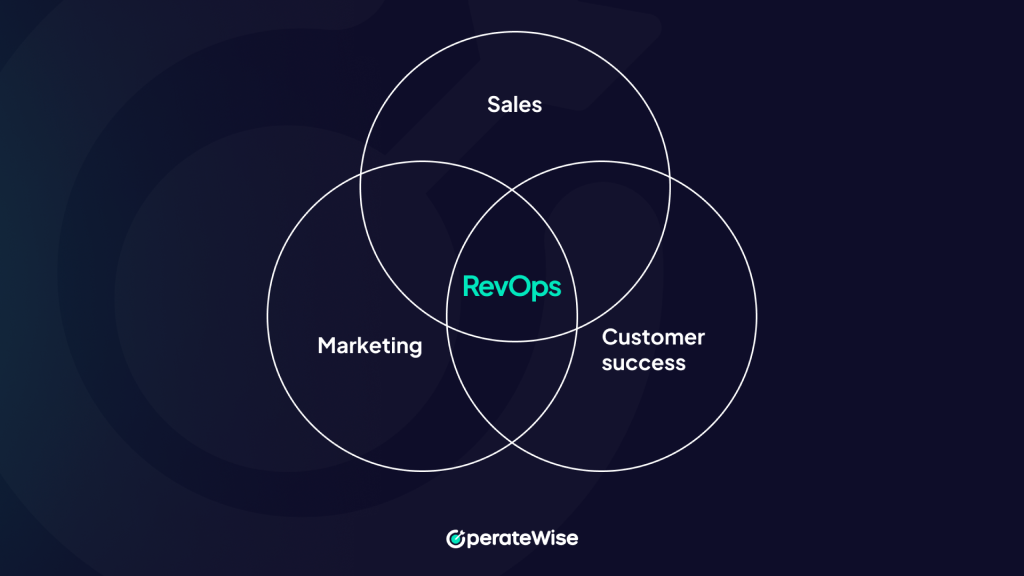A RevOps tech stack is a carefully chosen suite of technologies that integrates various departments – sales, marketing, and customer service – into a unified system. By breaking down data silos and fostering collaboration, this tech stack empowers businesses to streamline operations, improve efficiency, and ultimately, drive revenue growth.

The tech stack in RevOps seamlessly integrates sales, marketing, and customer service functions and enables you to streamline operations, optimize revenue generation, and enhance overall business performance. By breaking down data silos and fostering collaboration, tech stack empowers businesses to streamline operations, improve efficiency, and ultimately, drive revenue growth.
Here are 4 compelling benefits of opting for a RevOps tech stack:
Alignment and Visibility
Sales and marketing teams can finally see a complete customer journey, from initial touchpoint to purchase and beyond. This shared view fosters alignment and ensures everyone is working towards the same goal.
Automated Workflows
Repetitive tasks can be automated, freeing up valuable time for teams to focus on strategic initiatives. This can include automating lead nurturing, email campaigns, and even proposal generation.
Data-Driven Decision Making
A RevOps tech stack centralizes customer data, providing valuable insights into customer behavior, preferences, and buying patterns. This data can be used to inform marketing campaigns, personalize customer interactions, and improve sales strategies.
Improved Customer Experience
By streamlining communication and ensuring everyone has access to the same customer information, businesses can provide a more consistent and positive customer experience.
For SAAS/tech startups, leveraging the right technology stack is crucial to drive revenue excellence and achieve sustainable growth. RevOps help these startups compete by providing the tools and processes usually reserved for bigger players. This allows you to operate with greater efficiency, deliver a superior customer experience, and ultimately drive more revenue.
The ideal RevOps solution is flexible and adapts to your company’s needs. The numerous common tools that make up the tech stack are:
Customer Relationship Management (CRM) Systems:
CRM systems are the foundation of a robust RevOps technology stack. CRM acts as a central hub of data and is the single source of truth for your revenue teams. With CRM, you are now able to centralize customer data, track interactions, and enable effective sales pipeline management, customer segmentation, and forecasting.
By analyzing customer data in the CRM, RevOps teams can identify trends, understand customer behavior, and make informed decisions to improve sales and marketing efforts. Your RevOps team need not stay up at night because of the loss of revenue due to lead mismanagement. Operatwise’s RevOps Services is here to save your day.
Marketing Automation Tools:
Marketing automation tools are a crucial component of a RevOps tech stack. They streamline marketing processes, such as email marketing, lead nurturing, lead scoring, and lead generation, which frees up marketing teams to focus on more strategic initiatives. By automating these tasks, marketing automation tools can also help to improve efficiency and productivity. These tools enable personalized customer engagement, lead scoring, and marketing performance analysis.
Sales Engagement Platforms:
Sales engagement platforms facilitate efficient sales processes by providing tools for email tracking, sales cadences, meeting scheduling, and performance analytics. These platforms help sales teams prioritize leads, track engagement, and close deals effectively. Sales engagement platforms also provide valuable data on prospect engagement, allowing RevOps teams to identify areas for improvement and optimize the sales funnel for maximum efficiency and revenue generation.
Business Intelligence(BI) and Analytics:
Traditionally, data is a jumbled mess, a hidden treasure buried deep within your systems. BI tools act like magical shovels, unearthing valuable insights into sales performance, customer behavior, and revenue trends.
Business intelligence tools provide data visualization, analytics, and reporting capabilities. Also, the BI tools go beyond just presenting data; they translate it into actionable insights that can be easily implemented into your sales and marketing strategies. Armed with real-time insights, forecasts, and powerful analytics tools, businesses can make data-driven decisions that boost profitability and optimize key metrics.
Revenue Operations Analytics:
Unlike generic analytics tools, RevOps platforms provide a granular view of your sales funnel, marketing campaigns, and customer interactions. You can see exactly where leads enter the funnel, which marketing channels are most effective, and where potential drop-off points occur. By analyzing data across the entire revenue chain, these platforms pinpoint bottlenecks that might be slowing down your growth. Are leads getting stuck in the qualification stages? Are there delays in closing deals? RevOps analytics highlight these issues, allowing you to address them strategically.
Specialized revenue operations analytics platforms offer in-depth insights into revenue generation processes, allowing SMBs to optimize operations, identify bottlenecks, and drive revenue growth.
Customer Success and Support Tools:
Customer success and support tools enable SMBs to deliver exceptional customer experiences. These tools include customer support ticketing systems, knowledge bases, and customer feedback platforms, enhancing customer satisfaction and retention.
By investing in customer success and support tools, SMBs can create a customer-centric culture that fosters loyalty and drives sustainable growth. These tools are not just about resolving issues; they’re about building strong relationships and creating a positive brand experience for every customer.
Collaboration and Communication Tools:
Collaboration and communication tools facilitate seamless teamwork across sales, marketing, and customer success functions. They include project management platforms, team messaging apps, and video conferencing tools, enabling effective collaboration and information sharing. These tools are not just features; they’re the foundation for a well-oiled revenue engine in an SMB.
By investing in these tools, SAAS/tech startups can break down silos between teams, foster a culture of collaboration, and ultimately drive growth through a unified and efficient approach.
Adopting the right technology stack is essential for SMBs to achieve revenue excellence. By carefully selecting and integrating these technologies, addressing potential challenges, and ensuring scalability, SMBs can drive revenue growth, improve efficiency, and thrive in a competitive market landscape. Embrace the latest RevOps technology stack to unlock your SMB’s full revenue potential and achieve sustainable success. Want to know how your tech stack is impacting your revenue operations? Try our RevOps Health Health Check Tool for free and get a confidential RevOps screening.






